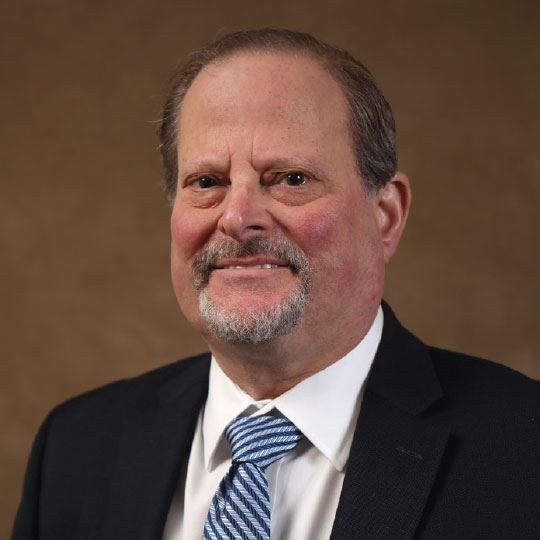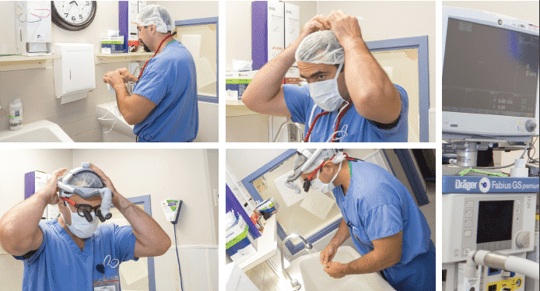Thanks to spine surgery at Robert Wood Johnson University Hospital Hamilton, a physician can walk without pain.

In the summer of 2019, Robert Silverbrook, DO, an internist with RWJBarnabas Health Medical Group, was suffering from debilitating back and leg pain. He had to drive down his driveway to get his mail because it was too painful to walk. When he went to work, he always had to worry about finding a parking spot close to the door. When he visited his children in another state, he had to stop at rest stops because he couldn’t sit for long.
“I was in pain every minute, and I was becoming more and more inactive,” recalls Dr. Silverbrook. “The discomfort radiated down my back into my left thigh below my knee. I took anti-inflammatory medications, but I knew I needed surgery.”
Unfortunately, this wouldn’t be his first spine surgery. Dr. Silverbrook had already had four procedures. The most recent one, a discectomy—in which a herniated or bulging spinal disk is removed to relieve pressure on the spinal cord—was done in 2018. Initially, he experienced relief from the pain, but it didn’t last long. He tried cortisone injections and physical therapy, but neither helped.

Dr. Silverbrook had previously worked with Erol Veznedaroglu, MD, a neurosurgeon at The Center for Neurosciences at Robert Wood Johnson University Hospital (RWJUH) Hamilton, so he contacted him. Dr. Veznedaroglu recommended that Dr. Silverbrook see his partner, Zakaria Hakma, MD, FACS, FAANS, Section Chief, Neurosurgery, RWJUH Hamilton, and a minimally invasive spine surgery specialist.
“Over time, Dr. Silverbrook had developed a very high tolerance for pain,” says Dr. Hakma. “For him to complain and seek another surgical opinion indicated that he suffered from quite a bit of discomfort.”
A Complicated Procedure
An MRI of Dr. Silverbrook’s lumbar spine revealed that he had what’s known as “adjacent segment disease,” which can develop as a result of spinal fusion surgery or degenerative changes in the spine. When spinal segments—composed of an intervertebral disc, vertebrae above and below the disc, joints, and ligaments—are fused during surgery, they no longer move. As a result, the healthy adjacent segments move more, and they become stressed. This can lead to degenerative disorders in the spine, such as herniated discs and osteoarthritis.
In Dr. Silverbrook’s case, he also had spondylolisthesis, in which a spinal bone (vertebra) slips forward, causing back and leg pain.
Dr. Silverbrook needed another procedure to remove damaged spinal discs. He also needed surgery to remove facet joints, which compress nerve roots when they’re damaged or degenerated, and the bony “roof” of the spinal canal. The goal was to relieve pressure on spinal nerves. Afterward, Dr. Hakma would use bone graft material and screws to stabilize Dr. Silverbrook’s spine.
Dr. Silverbrook was confident in Dr. Hakma’s expertise. In addition, “He has a calming presence,” he says.

A Successful Outcome
Dr. Silverbrook had surgery on January 29 at RWJUH Hamilton, and it went smoothly. Three neurosurgeons, including his former coworker, Dr. Veznedaroglu, performed the procedure.
“Multiple previous surgeries and old hardware required us to perform an open procedure,” says Dr. Hakma.
The night of the surgery, Dr. Silverbrook was able to walk the hallways of the hospital. “I was sore, but I didn’t have pain in my back or leg,” he says.
He spent two days in the hospital.
“The care on the orthopedic floor was tremendous,” he says. “The nurses were very attentive.”
About one week after the surgery, Dr. Silverbrook was able to walk to his mailbox. Two weeks later, he was able to go to the grocery store and carry light bags (around five pounds each). During his recovery, Dr. Silverbrook worked with a trainer. On March 1, he returned to work.
“The procedure was successful,” he says. “My goal was to be able to walk a mile without any leg pain and play golf. Now I can golf, swim, and walk without any pain. This surgery has given me my life back. It’s hopefully my last one.”
Learn more about The Center for Neurosciences at Robert Wood Johnson University Hospital Hamilton.